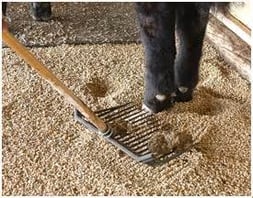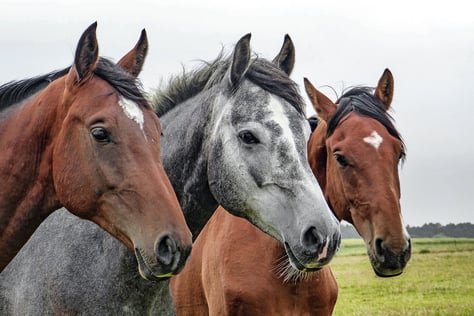 For many years, straw was the preferred bedding for most horse owners. It was dust free, comfortable and easy to compost. According to Brett Scott, PhD, extension horse specialist at Texas A&M University, straw also made a good bed because it dried well and stayed fairly clean if manure is picked out often, but it was not as absorbent as some other types of bedding. And was definitely more labor intensive to maintain. "It can be difficult to clean; you typically have to remove a large amount to clean out the manure and, thus, end up using more total bedding," says Scott. Over the years, several other types of stall bedding have been developed, included shavings and, one of the newest, wood pellet bedding.
For many years, straw was the preferred bedding for most horse owners. It was dust free, comfortable and easy to compost. According to Brett Scott, PhD, extension horse specialist at Texas A&M University, straw also made a good bed because it dried well and stayed fairly clean if manure is picked out often, but it was not as absorbent as some other types of bedding. And was definitely more labor intensive to maintain. "It can be difficult to clean; you typically have to remove a large amount to clean out the manure and, thus, end up using more total bedding," says Scott. Over the years, several other types of stall bedding have been developed, included shavings and, one of the newest, wood pellet bedding.
What are wood bedding pellets? According to horsemart.com, you can think of wood pellet bedding as a super compressed form of fine wood shavings. These fine fibers are very low in dust, free of allergens, easy to clean and very absorbent. Pellets made of pure soft wood produce only minimal fine, airborne dust or odors that can sometimes come from other products and cause respiratory problems in horses.
Once you have initially laid a stable, the pellets will absorb moisture from the stable environment and develop into soft wood. Some people add a misting of water after laying the pellets to turn them into soft wood fibers. when the pellets are dampened they expand to several times their original volume. Most companies under rigorous quality controls throughout the manufacturing process to ensure that the bedding you receive is the ultimate dust control, absorbency and durability. Mucking out time is reported to be reduced by as much as ½ when using wood pellet bedding.
There is another reason wood pellet bedding is advantageous over other forms. It is better for the environment. Conservation groups like the Alameda County (California) Conservation Partnership believe one of the major benefits of the use of this material is the 40-60% reduction in the quantity of the waste material (soiled bedding) that is generated. Horse waste may be managed at the site, composted, applied to farmland, or unfortunately in some cases, is sometimes merely disposed of in landfills. Using wood bedding pellets enhances compostability which allows a higher proportion of manure to bedding from stall waste in the compost pile. From the perspective of natural resources conservation and environmental stewardship, reducing the volume of waste material is a positive step that horse facilities can take to become “environmentally friendly”. Horse facility owners are increasingly being asked by local regulatory agencies to develop facility manure management plans in order to get operating permits.
One of the first manufacturers of wood pellet bedding in the Northwest U.S. was Eagle Valley ABM. Now called Talon ABM, it is still widely available in our area. While how wood pellet bedding is produced may differ by manufacturer, here’s how Talon ABM is made. ABM (Advanced Bedding Management) comes from raw pine material, only sourced from sawmills that cut more than 85-90% pine, with occasional portions of White Fir. There are no additives or chemicals involved. The product is manufactured from 100% wood. At no point during any part of the process is any other substance, other than clean water, blended in with the raw material. During manufacturing of the product, raw material has essentially been sterilized. Material is dried for up to thirty minutes at a range of 800°F down to 145°F at the conclusion of the drying process. The product is then subjected to approximately 20-30,000 PSI pressure, increasing temperature back up to approximately 200°F prior to cooling to room temperature. The product is packaged in clear bags so that the quality of the product can be seen.
Nature’s Bedding is also made of pine and provides the same benefits. They helpfully provided a “how to” for a 12 x 12 stall setup. Remember that no two animals are the same. Every animal and their owner are different –experiment to see what works best for you and your animals.
INITIAL SET UP:
Step 1 – Completely strip the stall
Step 2 – Choose either a Thin or Thick Bedding Preference
THIN – evenly spread 4-5 bags of NB throughout the stall
THICK – evenly spread 6-8 bags of bedding throughout the stall
Optional step - Some horse owners prefer to lightly mist the pellets with water immediately after spreading – this instantly creates a softer stall.
DAILY MAINTENANCE:
Step 3 - Rake dry bedding from the perimeter of the stall to the wet/damp areas. Remove manure from raked areas.
Step 4 - Add additional bedding as necessary. Adding 1 bag per week is common.
WEEKLY/MONTHLY MAINTENANCE (every 1-4 weeks based on personal preference).
Step 5 – Completely strip the stall and begin the process again.
In conclusion, most users of wood pellet bedding feel it provides the horse a healthier, brighter, cleaner living area. Its superior moisture absorption controls ammonia and odor. Ease of manure clean up reduces insect attraction. Both cost and time to clean/bed stalls is reduced. The environmentally friendly aspect makes waste easier and faster to compost and have removed.



